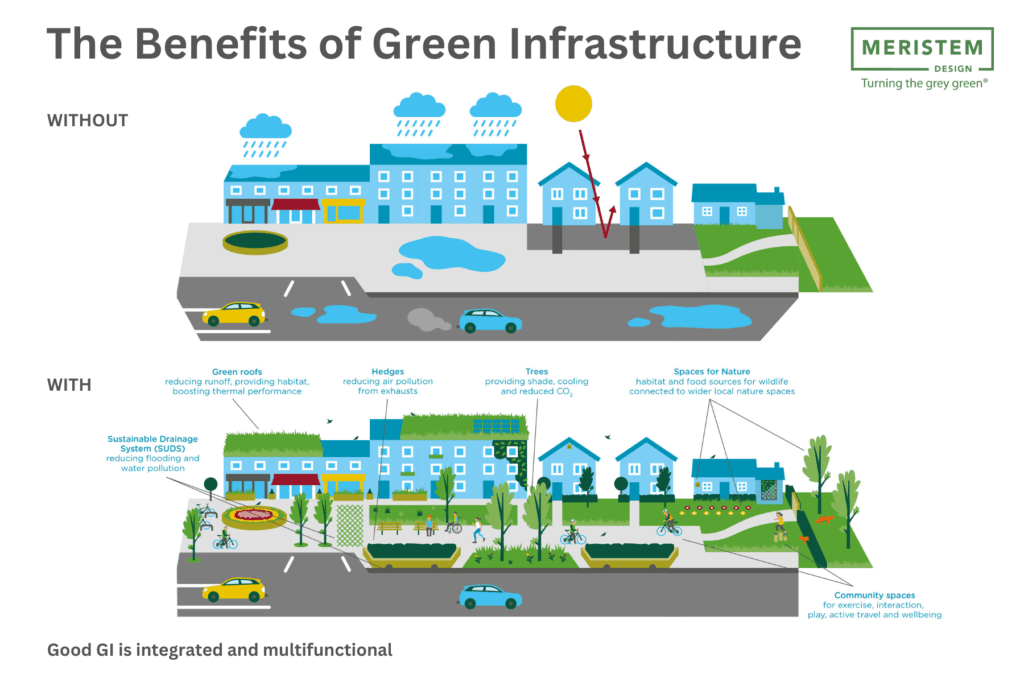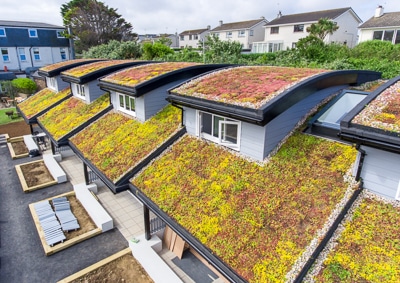
Building a Greener Tomorrow: A Comprehensive Guide to Sustainable Green Infrastructure Policy
The world is at a crossroads. We face the undeniable reality of climate change, rapid urbanization, and the depletion of natural resources. But amidst these challenges lies an opportunity – the chance to build a more sustainable and resilient future. At the heart of this transformation is sustainable green infrastructure policy, a framework designed to integrate nature into our built environment, creating healthier, more vibrant, and environmentally sound communities. This comprehensive guide will delve into the intricacies of green infrastructure policy, exploring its benefits, implementation strategies, and the crucial role it plays in shaping a better tomorrow.
What is Sustainable Green Infrastructure?
Before we explore the policies, let’s define what we mean by sustainable green infrastructure. It encompasses a network of natural and semi-natural elements that provide multiple benefits for both people and the environment. Think of it as a strategic approach to managing and utilizing natural systems, rather than simply replacing them with concrete and steel. This includes a wide array of elements, such as:
- Green Spaces: Parks, gardens, urban forests, and other areas with vegetation.
- Green Buildings: Structures designed with features like green roofs, living walls, and rainwater harvesting systems.
- Blue Infrastructure: Water bodies like rivers, lakes, wetlands, and constructed wetlands.
- Green Streets: Streets that incorporate features like bioswales, permeable pavements, and tree-lined sidewalks.
- Naturalized Areas: Restored ecosystems and habitats that support biodiversity.
The key is that these elements are designed to work together as an integrated system, providing a range of ecosystem services that benefit society. These services include:
- Improved Air and Water Quality: Vegetation filters pollutants and reduces runoff.
- Climate Change Mitigation and Adaptation: Reducing the urban heat island effect, carbon sequestration, and providing resilience to extreme weather events.
- Enhanced Biodiversity: Creating habitats for wildlife and supporting ecosystem health.
- Public Health Benefits: Providing opportunities for recreation, reducing stress, and improving mental well-being.
- Economic Benefits: Increasing property values, creating jobs, and reducing infrastructure costs.
The Importance of Green Infrastructure Policy
While individual green infrastructure projects are valuable, they are most effective when implemented as part of a comprehensive policy framework. Green infrastructure policy provides the roadmap for integrating these elements into urban and rural planning, ensuring that they are strategically located, adequately funded, and sustainably managed. Here’s why it matters:
- Long-Term Vision: Policies provide a long-term vision and commitment to green infrastructure, ensuring that these projects are not just one-off initiatives but are integrated into the fabric of the community.
- Strategic Planning: Policies guide the strategic planning process, helping to identify priority areas for green infrastructure investments and ensure that projects are aligned with broader community goals.
- Funding and Resources: Policies can establish funding mechanisms and provide resources for green infrastructure projects, making them more likely to be implemented and sustained.
- Collaboration and Coordination: Policies can foster collaboration between different stakeholders, including government agencies, developers, community groups, and the private sector.
- Equity and Access: Policies can ensure that green infrastructure benefits are distributed equitably across all communities, including those that are underserved.
- Resilience: Green infrastructure enhances the resilience of communities to climate change impacts like flooding and extreme heat.
Key Elements of a Successful Green Infrastructure Policy
Developing a robust and effective green infrastructure policy requires careful consideration of several key elements. These elements work together to create a framework that supports the planning, implementation, and maintenance of green infrastructure projects. Here are some of the most important components:
1. Clear Goals and Objectives
The policy should begin with clearly defined goals and objectives. What do you want to achieve with your green infrastructure? Do you want to improve air quality, reduce stormwater runoff, increase biodiversity, or enhance public health? These goals should be specific, measurable, achievable, relevant, and time-bound (SMART). Having clear goals provides a solid foundation for the rest of the policy and helps to ensure that projects are aligned with the overall vision.
2. Comprehensive Planning
Green infrastructure should be integrated into all aspects of urban and rural planning. This includes comprehensive plans, zoning regulations, and development codes. The policy should identify priority areas for green infrastructure investments, such as areas with high levels of pollution, limited access to green space, or a high risk of flooding. It should also establish standards for green infrastructure design, construction, and maintenance.
3. Funding and Incentives
Securing adequate funding is crucial for the success of any green infrastructure policy. The policy should identify potential funding sources, such as government grants, private investment, and public-private partnerships. It should also explore the use of incentives, such as tax breaks, density bonuses, and expedited permitting processes, to encourage developers to incorporate green infrastructure into their projects. Funding can come from a variety of sources, including:
- Government Budgets: Allocations from local, state, and federal government budgets.
- Grants: Competitive grants from government agencies and foundations.
- Tax Increment Financing (TIF): Using increased tax revenues generated by development in specific areas to fund green infrastructure projects.
- Developer Contributions: Requirements for developers to incorporate green infrastructure into their projects.
- Private Investment: Attracting private investment through public-private partnerships.
4. Stakeholder Engagement
Involving stakeholders in the policy development and implementation process is essential. This includes government agencies, developers, community groups, environmental organizations, and the private sector. Stakeholder engagement can help to build consensus, identify potential challenges, and ensure that the policy reflects the needs and priorities of the community. This can be achieved through public workshops, online surveys, and advisory committees.
5. Performance Monitoring and Evaluation
The policy should include a system for monitoring and evaluating the performance of green infrastructure projects. This involves tracking key metrics, such as the amount of stormwater runoff reduced, the number of trees planted, and the improvement in air quality. The data collected should be used to assess the effectiveness of the policy and to make adjustments as needed. This ongoing evaluation is essential for ensuring that the policy is achieving its intended goals and for making improvements over time.
6. Education and Outreach
Educating the public about the benefits of green infrastructure is crucial for building support for the policy and for encouraging its adoption. This can be achieved through public awareness campaigns, educational programs, and community events. The policy should also provide training and technical assistance to developers, designers, and other professionals to ensure that they have the knowledge and skills needed to implement green infrastructure projects effectively. Effective outreach includes:
- Public Awareness Campaigns: Informing the public about the benefits of green infrastructure.
- Educational Programs: Providing educational opportunities for schools, community groups, and professionals.
- Community Events: Hosting events that showcase green infrastructure projects and promote environmental awareness.
- Technical Assistance: Providing technical assistance to developers and designers.
Implementing a Green Infrastructure Policy: A Step-by-Step Approach
Implementing a green infrastructure policy is a complex process that requires careful planning, coordination, and execution. Here’s a step-by-step approach to guide the process:
- Assessment and Planning:
- Conduct a comprehensive assessment of existing green infrastructure assets and needs.
- Identify priority areas for green infrastructure investments.
- Develop a detailed implementation plan with specific goals, objectives, and timelines.
- Policy Development:
- Draft the green infrastructure policy, incorporating the key elements outlined above.
- Engage stakeholders in the policy development process.
- Revise the policy based on stakeholder feedback.
- Obtain necessary approvals from relevant government bodies.
- Implementation:
- Secure funding and resources for green infrastructure projects.
- Implement the policy through zoning regulations, development codes, and other mechanisms.
- Provide training and technical assistance to developers and designers.
- Monitor and evaluate the performance of green infrastructure projects.
- Maintenance and Management:
- Establish a system for the long-term maintenance and management of green infrastructure assets.
- Develop a funding mechanism for ongoing maintenance.
- Regularly inspect and maintain green infrastructure projects to ensure their continued effectiveness.
Examples of Successful Green Infrastructure Policies
Many cities and regions around the world have successfully implemented green infrastructure policies. Here are a few notable examples:
- New York City, USA: The city’s Green Infrastructure Plan focuses on using green infrastructure to manage stormwater runoff and improve water quality. The plan includes green roofs, bioswales, and permeable pavements.
- Portland, Oregon, USA: Portland’s comprehensive green infrastructure program includes green streets, urban forests, and natural area restoration. The city uses a combination of regulations, incentives, and public education to promote green infrastructure.
- Philadelphia, Pennsylvania, USA: Philadelphia’s Green City, Clean Waters program utilizes green infrastructure to reduce combined sewer overflows and improve water quality. The program includes green stormwater infrastructure projects throughout the city.
- Singapore: Singapore’s “City in a Garden” initiative integrates green infrastructure into all aspects of urban planning. The city has numerous green roofs, vertical gardens, and parks, making it a global leader in green infrastructure.
- Copenhagen, Denmark: Copenhagen’s climate adaptation plan includes extensive green infrastructure to manage stormwater and adapt to climate change impacts. The city has implemented green roofs, urban gardens, and green streets.
Challenges and Considerations
While the benefits of green infrastructure are clear, there are also challenges and considerations to keep in mind when developing and implementing a policy. These include:
- Cost: The initial cost of implementing green infrastructure projects can be higher than traditional infrastructure. However, these costs are often offset by long-term cost savings, such as reduced stormwater management expenses and improved public health.
- Maintenance: Green infrastructure requires ongoing maintenance to ensure its effectiveness. This can be a challenge, especially for projects that are not properly designed or managed.
- Public Acceptance: Gaining public acceptance for green infrastructure projects can be difficult, especially if the projects are perceived as being too expensive or aesthetically unappealing.
- Regulatory Barriers: Existing regulations and zoning codes may not always be conducive to green infrastructure. Policymakers may need to revise these regulations to support the implementation of green infrastructure projects.
- Land Availability: Finding suitable land for green infrastructure projects can be challenging, especially in densely populated areas.
- Climate Change Impacts: The changing climate can impact the performance of green infrastructure. It is important to consider climate change impacts when designing and implementing green infrastructure projects and develop strategies for adaptation.
The Future of Green Infrastructure Policy
The future of green infrastructure policy is bright. As the impacts of climate change become more apparent and as the benefits of green infrastructure become more widely recognized, we can expect to see more and more cities and regions adopting these policies. Here are some trends to watch:
- Integration with Smart City Technologies: Combining green infrastructure with smart city technologies, such as sensors and data analytics, to optimize performance and improve management.
- Focus on Equity and Environmental Justice: Ensuring that green infrastructure benefits are distributed equitably across all communities, including those that are underserved.
- Emphasis on Resilience and Adaptation: Designing green infrastructure projects to be more resilient to climate change impacts and to help communities adapt to a changing climate.
- Increased Private Sector Involvement: Engaging the private sector in the development and implementation of green infrastructure projects through public-private partnerships and other innovative financing mechanisms.
- Standardization and Best Practices: Developing standardized design guidelines, performance metrics, and best practices to ensure that green infrastructure projects are effective and sustainable.
The evolution of green infrastructure policy is a critical step toward creating sustainable, livable, and resilient communities. By embracing these policies, we can harness the power of nature to address some of the most pressing environmental and social challenges of our time.
Conclusion
Sustainable green infrastructure policy is no longer a niche concept; it is a necessity. As our planet faces unprecedented environmental challenges, the integration of nature into our built environment offers a powerful solution. Through thoughtful planning, strategic investments, and community engagement, we can create vibrant, healthy, and resilient communities that thrive in harmony with nature. By embracing green infrastructure, we are not just building infrastructure; we are building a greener, healthier, and more sustainable future for generations to come. The time to act is now. Let’s work together to build a world where nature and humanity flourish side by side.

